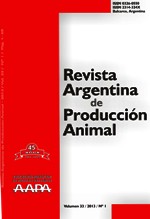Ver ítem
- xmlui.general.dspace_homeCentros Regionales y EEAsCentro Regional Santa FeEEA RafaelaArtículos científicosxmlui.ArtifactBrowser.ItemViewer.trail
- Inicio
- Centros Regionales y EEAs
- Centro Regional Santa Fe
- EEA Rafaela
- Artículos científicos
- Ver ítem
Pérdidas de preñez en un rodeo de cría del norte de la provincia de Santa Fe = Pregnancy losses in a beef cattle herd in northern Santa Fe
Resumen
Se evaluó durante tres años consecutivos las pérdidas por abortos en un rodeo de cría bovino, libre de brucelosis y tuberculosis, con control de enfermedades venéreas y aplicación de vacunas contra enfermedades reproductivas. En los meses de abril se determinaba el porcentaje de preñez y se chequeaba el total del rodeo a fin de corroborar el status libre de brucelosis, tuberculosis y descartar venéreas en los toros. Alícuotas de suero de cada vientre
[ver mas...]
Se evaluó durante tres años consecutivos las pérdidas por abortos en un rodeo de cría bovino, libre de brucelosis y tuberculosis, con control de enfermedades venéreas y aplicación de vacunas contra enfermedades reproductivas. En los meses de abril se determinaba el porcentaje de preñez y se chequeaba el total del rodeo a fin de corroborar el status libre de brucelosis, tuberculosis y descartar venéreas en los toros. Alícuotas de suero de cada vientre preñado se reservaron a fin de realizar serología seriada en caso de registrar un aborto. Durante junio y agosto se realizaron palpaciones rectales para constatar la continuidad de la preñez. Las hembras abortadas fueron muestreadas para detectar anticuerpos contra brucelosis, leptospirosis, IBR, DVB y neosporosis. Tricomoniasis y campylobacteriosis se determinaron a partir de moco cervical. La preñez obtenida para los tres períodos fueron de 83,2%; 87% y 72,8% y los abortos detectados fueron 4 (1,5%), 11 (3,5) y 8 (3,1%) respectivamente. Se observó serología a IBR, DVB y N. caninum, pero aumentos de títulos serológicos solo se observaron en 7 vacas (3 IBR y 4 N. caninum). Todas las vacas abortadas resultaron negativas a brucelosis y leptospirosis. Se aisló Campylobacter fetus a partir de moco cervical en dos vacas abortadas y un solo toro resultó positivo a esta enfermedad por IFD en el examen post servicio, el resto resultaron negativos a esta enfermedad y a tricomoniasis. Pese a detectarse campylobacteriosis y títulos serológicos a IBR, DVB y N. caninum, las pérdidas atribuibles a ellas serían bajas, dentro de las condiciones extensivas en que se desarrolla la cría bovina en el norte de la provincia de Santa Fe. Los productores deberían esforzarse en tener rodeos libres de brucelosis, tuberculosis y enfermedades venéreas ya que la ausencia de estas enfermedades, aseguran niveles elevados de preñez y bajos de merma entre tacto y parición.
[Cerrar]
Abortion losses were evaluated for three consecutive years in a beef cattle herd, free of brucellosis and tuberculosis, with venereal diseases control and preventive plan vaccination against bacterial and viral reproductive agents. In April pregnancy percentage was determinate and the whole herd was checked to control the free status of brucellosis, tuberculosis and
venereal diseases. Samples of serum of each pregnant cow were stored. In June and
[ver mas...]
Abortion losses were evaluated for three consecutive years in a beef cattle herd, free of brucellosis and tuberculosis, with venereal diseases control and preventive plan vaccination against bacterial and viral reproductive agents. In April pregnancy percentage was determinate and the whole herd was checked to control the free status of brucellosis, tuberculosis and
venereal diseases. Samples of serum of each pregnant cow were stored. In June and August
pregnancy was checked again and aborted cows were serological examine for brucellosis,
leptospirosis, IBR, DVB and N. caninum. Samples of cervical mucus were taken to determined trichomoniasis y campylobacteriosis. The pregnancy for the three periods was 83.2%; 87% y 72.8% and the abortion score was 1.5% (4), 3.5% (11) and 3.1% (8). Serological test were positive to IBR, DVB y N. caninum, but antibody level were increase only in seven cows (3 IBR y 4 N. caninum). All aborted cows were negative to brucellosis and leptospirosis. Campylobacter fetus was isolated in cervical mucus from two aborted cow and in one bull by IFD test; the
remained bulls were free of Campylobacter fetus and trichomoniasis. Even though Campylobacteriosis, IBR, DVB and N. caninum maybe present in the herd, their losses were minimum within the extensive condition that the beef cattle production is development in this
area of Santa Fe Province. Farmer must increase their effort to get herd free of brucellosis, tuberculosis and venereal illness because it is possible to get high levels of pregnancy and low rate of abortions without these pathogens
[Cerrar]

Fuente
Revista Argentina de Producción Animal 33 (2) : 109-115 (2013)
Fecha
2013-12
Editorial
Asociación Argentina de Producción Animal
ISSN
0326-0550
2314-324X
2314-324X
Formato
pdf
Tipo de documento
artículo
Palabras Claves
Derechos de acceso
Abierto
 Excepto donde se diga explicitamente, este item se publica bajo la siguiente descripción: Creative Commons Attribution-NonCommercial-ShareAlike 2.5 Unported (CC BY-NC-SA 2.5)
Excepto donde se diga explicitamente, este item se publica bajo la siguiente descripción: Creative Commons Attribution-NonCommercial-ShareAlike 2.5 Unported (CC BY-NC-SA 2.5)


